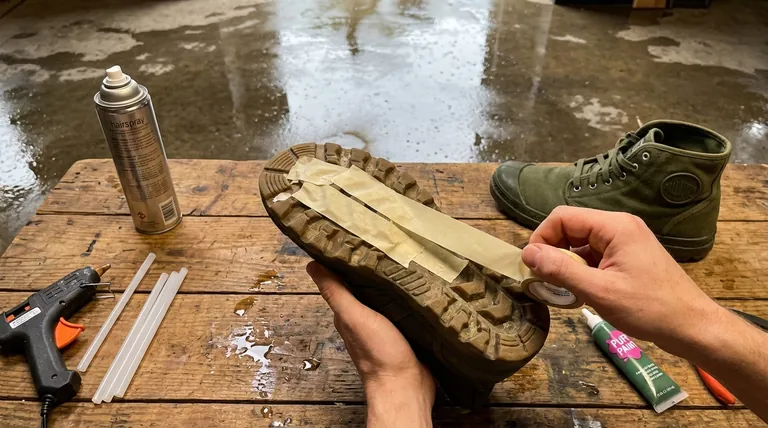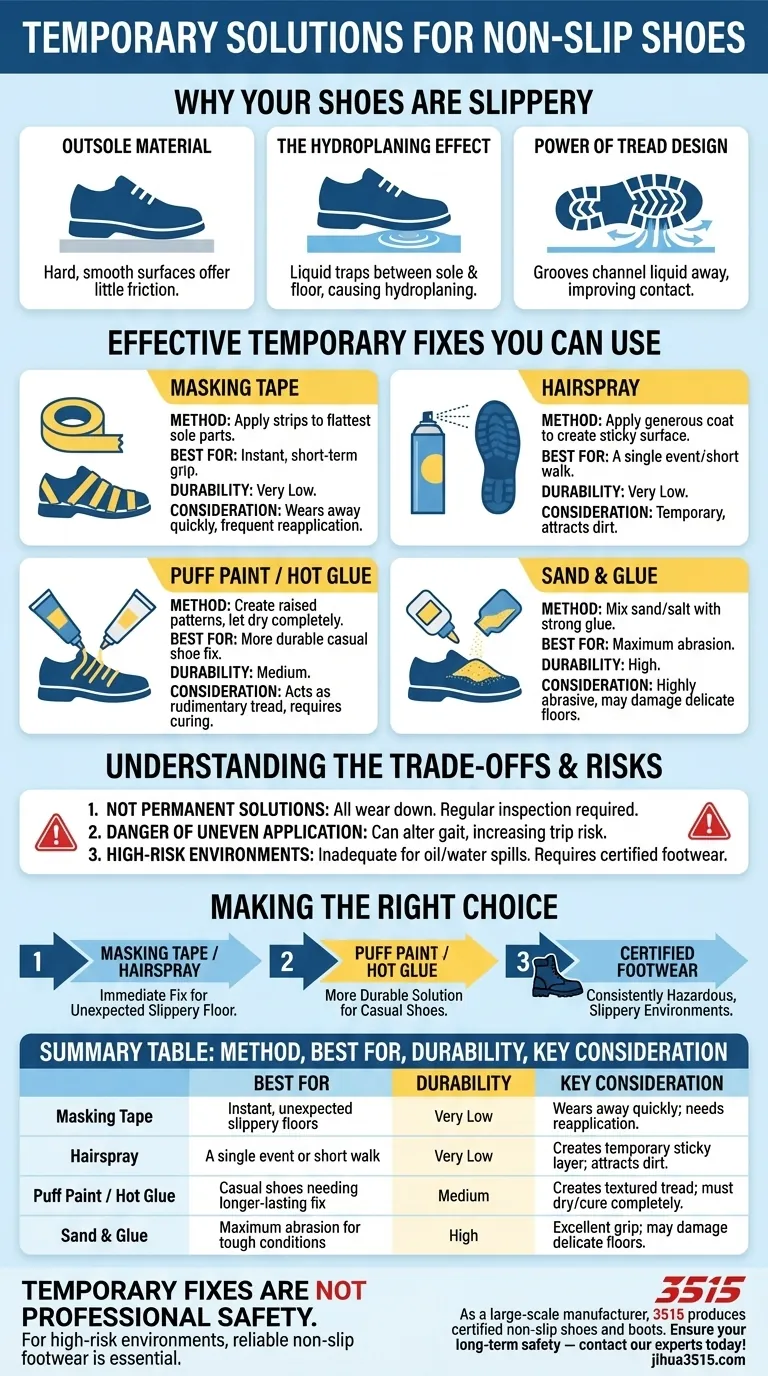For an immediate, temporary solution, you can apply masking tape to the bottom of your shoes to create a textured surface. Other household items like hairspray can also be used to create a short-term sticky layer, providing a quick boost in grip on unexpectedly slippery floors. These methods are simple but are not durable and will need frequent reapplication.
The most effective temporary solutions for slippery shoes work by adding a textured or abrasive layer to the outsole. While these quick fixes can increase grip in a pinch, they are not a reliable substitute for the engineered safety features of true non-slip footwear.

Why Your Shoes Are Slippery
Before fixing the problem, it's essential to understand its cause. A shoe's grip depends entirely on the design and material of its outsole, the part that contacts the ground.
The Role of Outsole Material
Shoes with hard, smooth outsoles made of leather or certain plastics offer very little friction. In contrast, non-slip shoes use soft rubber compounds that are designed to maximize contact and grip on the floor.
The Problem of Hydroplaning
When you step on a wet or oily surface, a thin layer of liquid can get trapped between your shoe and the floor. This prevents the sole from making solid contact, causing you to "hydroplane" and slip, much like a car tire on a wet road.
The Power of Tread Design
Proper non-slip shoes feature intricate tread patterns, often with hexagonal or circular channels. These grooves are engineered to push water and other liquids out from under the sole, allowing the rubber to maintain direct, firm contact with the ground.
Effective Temporary Fixes You Can Use
Several household items can mimic the properties of a non-slip sole, but they vary in durability and effectiveness.
For Instant, Short-Term Grip: Masking Tape
Placing strips of masking tape on the flattest parts of your shoe's sole adds immediate texture. The slightly rough surface of the tape increases friction, but it will wear away very quickly, especially on abrasive surfaces like pavement.
For a Tacky, Textured Coating: Hairspray
A generous coat of hairspray or spray adhesive on the sole creates a sticky surface that enhances grip. This is a very temporary fix that wears off fast and can attract dirt, but it's effective for a single event or a short walk.
For a More Durable DIY Tread: Puff Paint
Applying puff paint or lines from a hot glue gun to your soles and letting them dry creates a new, raised pattern. This textured layer acts as a rudimentary tread, offering a more durable solution than tape or spray.
For Maximum Abrasion: Sand and Glue
For a sandpaper-like effect, you can mix sand or salt with a strong adhesive like rubber glue and apply it to the soles. This creates a highly abrasive surface that provides excellent grip, though it may damage delicate floors.
Understanding the Trade-offs and Risks
While these DIY methods can help, they come with significant limitations that you must consider for your safety.
These Are Not Permanent Solutions
Every temporary fix will wear down with use. You must inspect your shoes regularly and reapply the solution as needed, as a worn-down fix offers a false sense of security.
The Danger of Uneven Application
Applying a thick layer of glue or paint unevenly can create an imbalance in your shoes. This can alter your gait and potentially increase the risk of twisting an ankle, trading one hazard for another.
When a Temporary Fix Is Not Enough
In high-risk environments like commercial kitchens, workshops, or any area with frequent oil and water spills, temporary solutions are inadequate. These situations demand professionally designed non-slip shoes with certified safety features.
Making the Right Choice for Your Situation
Your approach should match your specific need, balancing convenience against the level of safety required.
- If you need an immediate fix for an unexpected slippery floor: Masking tape or a quick coat of hairspray offers the fastest, most accessible solution.
- If you want a more durable solution for casual shoes: Applying puff paint or a silicone sealant and allowing it to fully cure will provide a longer-lasting textured grip.
- If you work or walk in consistently hazardous, slippery environments: Do not rely on temporary fixes; investing in certified non-slip footwear is the only appropriate choice for your safety.
Ultimately, understanding the principles of traction empowers you to make a more informed decision to prevent a dangerous fall.
Summary Table:
| Method | Best For | Durability | Key Consideration |
|---|---|---|---|
| Masking Tape | Instant, unexpected slippery floors | Very Low | Wears away quickly; needs frequent reapplication. |
| Hairspray | A single event or short walk | Very Low | Creates a temporary sticky layer; attracts dirt. |
| Puff Paint / Hot Glue | Casual shoes needing a longer-lasting fix | Medium | Creates a textured tread; must dry/cure completely. |
| Sand & Glue | Maximum abrasion for tough conditions | High | Provides excellent grip but may damage delicate floors. |
Temporary fixes are not a substitute for professional safety. For high-risk environments like commercial kitchens or workshops, reliable non-slip footwear is essential. As a large-scale manufacturer, 3515 produces a comprehensive range of certified non-slip shoes and boots for distributors, brand owners, and bulk clients. Our production capabilities encompass all types of safety footwear engineered for superior grip and durability. Ensure your long-term safety — contact our experts today to find the right solution for your needs!
Visual Guide

Related Products
- Factory-Direct Wholesale Canvas Boots with High-Traction Rubber Soles
- Customizable Slip-On Safety Shoes Direct from the Factory for Wholesale
- Customizable Anti-Smash Safety Boots for Wholesale & Private Label Manufacturing
- Premium Grain Leather Safety Boots for Bulk Supply
- Wholesale Comfort Leather Business Shoes with Dial Lacing System
People Also Ask
- What is a vulcanized sole? Discover the Secret to Superior Flexibility and Grip
- Why is rubber a popular material for shoe soles? Unbeatable Grip, Durability & Value
- What are the advantages of rubber soles in safety boots? Unbeatable Grip & Durability
- What should be avoided when storing boots with outsoles? Protect Your Investment from Dry Rot & Decay
- What types of rubber are typically employed in non-slip footwear soles? Your Guide to Maximum Grip and Safety



















